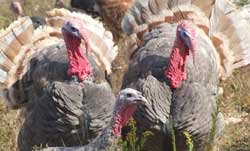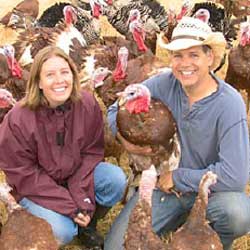



Parasite Management for Natural and Organic Poultry: Blackhead in Turkeys - Part 2
The second part of a two-part series covers the prevention and managment of blackhead disease. By Terrell Spencer, agriculture specialist with National Center for Appropriate Technology (NCAT) and published by the US National Sustainable Agriculture Information Service, ATTRA.
Prevention and Management of Blackhead Disease
Prevention is the key to successful blackhead management. Due to the previously mentioned banning of the antihistomonal medicines used to treat outbreaks, there are no established treatments for turkeys once they are infected and symptomatic. It is imperative that any truly sustainable turkey operation have a blackhead prevention plan.
Preventative and Post-Infection Measures
The most economical and sustainable method of Blackhead management is complete avoidance of the disease through preventive treatments.
- Separation of poultry flocks by species and age – Separation of susceptible (turkeys and peafowl) and resistant (chickens, pheasants, quail etc.) poultry species has been the principal means of histomoniasis prevention since the cecal worm role in disease transmission was identified in the 1930s. Separation should also include ground that has been used for different poultry species. Land that has been used to house/pasture chickens or gamebirds should not be used for turkeys or peafowl production.
- Fallowing of contaminated ground or houses – Caecal worm eggs are viable up to three years in the soil and litter, and research has shown that H. meleagridis harbored inside of the eggs remains infectious even after 150 weeks. Therefore, three years should be the minimum time considered for fallowing.
- Selecting for resistance – While this strategy is not plausible for Broadbreasted Whites, heritage turkeys can be selected for resistance to Blackhead. If a Blackhead outbreak occurs in a heritage flock, the surviving individuals may have some trait, either genetic or behavioural, that increases their chance of surviving or avoiding a blackhead infection. These birds could be saved and bred to obtain next season's poults, and at least some resistance to Blackhead could be bred into a producer’s flock.
- Preventative feed additives
- HistostatTM (active ingredient is Nitarsone) is an effective preventative feed additive and can be premixed into feed. It is a non-organic additive that contains arsenic and is the only drug approved for the prevention of Blackhead. At the time of this writing, Blue Seal FeedsTM, located in the Northeastern and Mid-Atlantic regions of the United States, sells a pre-mixed medicated turkey feed containing Histostat.
Other than within the Blue Seal product, the use of Histostat is difficult at best for a small producer. The drug is only sold in 55-pound bags – enough Histostat to mix more than 65 tons of feed. Additionally, the drug can only be purchased by registered feed mills, and Histostat must be mixed into the ration as the feed is milled. Finally, at approximately $15 per pound, Histostat is a costly drug to buy in bulk. Histostat cannot be fed to actively producing layers and has a short withdrawal period (five days) to allow the arsenic ingested by the bird to be flushed from the system. In addition, Histostat is toxic to dogs, ruminants and waterfowl. The toxicity to other species is an additional burden to mills that must thoroughly clean their feed machinery before mixing non-poultry feeds.
- NatustatTM is a plant-based additive manufactured by Alltech, Inc. that, just like Histostat, is mixed into the ration when the feed is milled. Natustat promotes poultry well-being and discourages Blackhead by acting as an immune system booster that stimulates good health. The company's research trials have shown that it is comparable to Histostat in the prevention of blackhead when birds are exposed to infected litter, but it is not effective in preventing Blackhead when poultry are exposed to the parasite directly (as through cloacal drinking).
Natustat is available to small growers directly in 55-pound bags. During the summer of 2010, the price per bag was $175, enough to treat 25 tons of feed. Natustat does not have the legal purchasing restrictions that make Histostat so difficult for small producers to access. There is no withdrawal time, and there is no secondary toxicity threat to other animal species.
Feed additives are effective only if administered before a blackhead infection occurs. Once signs of infection are present (yellow faecal matter, behavioural signs), preventative drugs are no longer effective. There are no legal drugs or substances to treat histomoniasis once the infection has occurred.
- Dimetridazole was a low-cost, highly effective drug that was once used to cure infected turkey flocks and regenerate liver damage. The drug was banned in 1988 in the US and the late 1990s in Europe.
- Capsicum from hot peppers (i.e. cayenne) has anecdotal success as a natural treatment for blackhead disease. However, the effectiveness of treating blackhead with capsicum has not been verified through documented research.
- HistostatTM (active ingredient is Nitarsone) is an effective preventative feed additive and can be premixed into feed. It is a non-organic additive that contains arsenic and is the only drug approved for the prevention of Blackhead. At the time of this writing, Blue Seal FeedsTM, located in the Northeastern and Mid-Atlantic regions of the United States, sells a pre-mixed medicated turkey feed containing Histostat.
- Promotion of good health and robust immune systems – Generally, a stressed animal is more susceptible to any disease, so reducing the stresses (by providing adequate shelter, balanced feed, proper stocking densities, clean water access) in turkeys and other poultry can help develop robust immune systems less susceptible to blackhead. As mentioned before, running out of feed can allow establishment of H. meleagridis through oral ingestion, so care must be taken to assure that feeders are never empty.
- Good biosecurity techniques – Infected caecal worm eggs can be transported on the bottom of boots/equipment into brooders, clean pastures, land and poultry houses. On small farms, where multiple poultry species are often kept, pay particular care when incorporating new stock from off the farm into the existing operation. When possible, chores and farm activity should be planned around dealing with susceptible poultry first and dealing with resistant species later when blackhead is suspected or a concern. The American Livestock Breed Conservancy (ALBC) has excellent resources for addressing a farm's biosecurity needs. The resources can be viewed on their web site [click here].
- Encouragement of roosting behaviour – Getting poultry off the ground and onto roosts reduces the chance of cloacal contact with infected fecal matter. Turkeys and other poultry will huddle together and sleep on the ground in absence of a suitable roost. The direct contact from huddling greatly increases the chance of blackhead transmission as the birds defecate through the night. Heritage breeds of turkeys will roost instinctively. Broadbreasted Whites and Bronzes have difficulty flying onto roosts due to their size but can be coaxed into roosting by providing a ladder or some type of plane.
Management During Infections
- Frequent movement to fresh ground – Once a flock has been infected with Blackhead, frequently moving the flock to fresh pasture minimizes the amount of manure and exposure time that the birds are subject to the pathogens shed in the infective manure.
- Isolation of sick birds – Isolation of sick birds removes the source of direct transmission from the flock. Identification of sick birds before behavioral signs develop can occur by spotting the birds that expel the yellow manure characteristic to the disease.
- Reduction in stocking rate – Reducing the amount of birds in a given unit of area (acre, paddock, etc.) has an effect similar to moving the turkeys to fresh ground.
- Encourage natural sterilization – Ultraviolet light from sunshine, the drying action of wind, the heat of summer, and the chill of winter are all detrimental to the survival of H. meleagridis. Any natural weathering process that breaks down poultry manure – and therefore the hospitable niche of the blackhead pathogen – should be encouraged. H. meleagridis requires moisture to survive and spread, and moving the flock to dry ground makes the spread of blackhead more difficult.
- Preventative feed additives – Once blackhead has appeared in the flock, it is of critical importance to prevent the rest of the flock from becoming infected. Feed preventatives can be a powerful tool against contraction or the spread of blackhead in poultry flocks.
Conclusion
Blackhead is a serious disease in poultry that has affected poultry farmers in the United States for well over a century. Turkeys and peafowl are highly susceptible to death from the disease. Chickens are excellent carriers of blackhead, and care must be taken to keep chickens and turkeys separate.
There is no treatment for blackhead, and so the best strategy is prevention.
Breeding Resistance into the Flock – Nature's Harmony Farm

Located in Elberton, Georgia, Nature's Harmony Farm is a 126- acre diversified meat and dairy farm built by Tim and Liz Young. Raising pasture-based pork, poultry, cattle, sheep and rabbit, as well as running a grass-fed dairy, the Youngs have taken a holistic approach towards the management of their farm. Tim and Liz examine all of their endeavours with an eye towards long-term biological sustainability. One critical objective of Nature's Harmony Farm's holistic planning is breeding disease resistance into their livestock, including blackhead resistance in turkeys.
"Now that we're breeding our own animals on the farm," says Mr Young, "we worry a lot less about disease mortality problems. We had such huge issues with pastured poultry two years ago with blackhead, sinusitis, mycoplasma, etc., which we either don't see any more or see drastically less of. Our birds look so healthy now, but just a few years ago, we had depressing mortality rates among birds that were shipped in from commercial hatcheries. We'd have experts come out, and they'd say 'Just burn your entire flock and start all over again'. We said no, we're going to build resistance to blackhead, and all the other diseases. We raise turkeys with our chickens, we don't worry about any of these things, and we just let nature sort it out."
Ms Young added: "We find the strongest birds, those are the ones we breed and their offspring have proven to be so much hardier than all the other animals on the farm. It will take a number of years to get where we want to be, but the results so far give us a lot of hope."
"This was a huge, calculated risk we took as new farmers a couple of years ago," Mr Young acknowledges, "but we were so convicted in our values that we felt it was the right thing to do, even though it was counter to all the advice. We're really happy with the decisions we made back then, and with the health of the birds we have today."
References
- Davidson, W.R. and G.L. Doster. 2010. Blackhead Does Not Cause Blackhead. National Wild Turkey Federation. Bulletin 25.
- Hu, J., L. Fuller and L.R. McDougald. 2004. Infection of Turkeys with Histomonas meleagridis by the Cloacal Drop Method. Avian Diseases. 48: 746-750.
- Lund, E.E. and A.M. Chute. 1972. Reciprocal Responses of Eight Species of Galliform Birds and Three Parasites: Heterakis gallinarum, Histomonas meleagridis, and Parahistomonas wenrichi. Journal of Parasitology, 58: 40-945.
- McDougald, L.R. 2005. Blackhead Disease (Histomoniasis) in Poultry: A Critical Review. Avian Diseases, 49: 462–476.
- McDougald, L.R. and L. Fuller. 2005. Blackhead Disease in Turkeys: Direct Transmission of Histomonas meleagridis from Bird to Bird in a Laboratory Model. Avian Diseases, 49:328–331.
Further Reading
| - | You can view the first part of this ATTRA publication by clicking here. |
Further Reading
| - | Find out more information on blackhead by clicking here. |
November 2010








